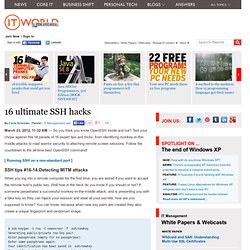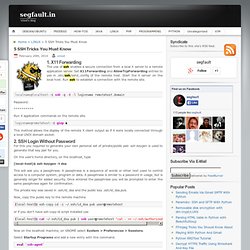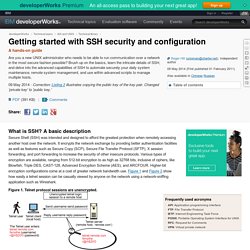

16 ultimate SSH hacks. March 23, 2012, 11:32 AM — So you think you know OpenSSH inside and out?

Test your chops against this hit parade of 16 expert tips and tricks, from identifying monkey-in-the-middle attacks to road warrior security to attaching remote screen sessions. Follow the countdown to the all-time best OpenSSH command! [ Running SSH on a non-standard port ] SSH tips #16-14:Detecting MITM attacks When you log into a remote computer for the first time, you are asked if you want to accept the remote host's public key. . $ ssh-keygen -t rsa -C newserver -f .ssh/newkey Generating public/private rsa key pair. SSH tip #16: Retrieve the fingerprint and randomart image of an SSH key If you make a copy of this when you create new encryption keys, then you can fetch a key's fingerprint and randomart image anytime to compare and make sure they have not changed: $ ssh-keygen -lvf keyname SSH tip #15: View all fingerprints and randomart images in known_hosts And you can see all of them in your ~/.ssh/known_hosts file: 5 SSH Tricks You Must Know.
1.

X11 Forwarding The use of ssh enables a secure connection from a local X server to a remote application server. Set X11Forwarding and AllowTcpForwarding entries to yes in /etc/ssh/sshd_config of the remote host. Start the X server on the local host. Run ssh to establish a connection with the remote site. Password: Run X application commands on the remote site.
This method allows the display of the remote X client output as if it were locally connected through a local UNIX domain socket. 2. For this you required to generate your own personal set of private/public pair. ssh-keygen is used to generate that key pair for you. On the user’s home directory, on the localhost, type [local-host]$ ssh-keygen -t dsa This will ask you a passphrase. The private key was saved in .ssh/id_dsa and the public key .ssh/id_dsa.pub. Now, copy the public key to the remote machine. Getting started with SSH security and configuration. What is SSH?

A basic description Secure Shell (SSH) was intended and designed to afford the greatest protection when remotely accessing another host over the network. It encrypts the network exchange by providing better authentication facilities as well as features such as Secure Copy (SCP), Secure File Transfer Protocol (SFTP), X session forwarding, and port forwarding to increase the security of other insecure protocols.
Various types of encryption are available, ranging from 512-bit encryption to as high as 32768 bits, inclusive of ciphers, like Blowfish, Triple DES, CAST-128, Advanced Encryption Scheme (AES), and ARCFOUR. Higher-bit encryption configurations come at a cost of greater network bandwidth use. Figure 1. When using an unsecured, "clear text" protocol such as telnet, anyone on the network can pilfer your passwords and other sensitive information. Figure 2. Whatever your operating system, SSH touts many positive benefits for commonplace, everyday computing.
Back to top #! SSH Tutorial for Linux - Support Documentation. This document covers the SSH client on the Linux Operating System and other OSes that use OpenSSH.

If you use Windows, please read the document SSH Tutorial for Windows If you use Mac OS X or other Unix based system, you should already have OpenSSH installed and can use this document as a reference. This article is one of the top tutorials covering SSH on the Internet. It was originally written back in 1999 and was completely revised in 2006 to include new and more accurate information. As of October, 2008, it has been read by over 473,600 people and consistently appears at the top of Google's search results for SSH Tutorial and Linux SSH.
What Is SSH? There are a couple of ways that you can access a shell (command line) remotely on most Linux/Unix systems. An unencrypted telnet session SSH, which is an acronym for Secure SHell, was designed and created to provide the best security when accessing another computer remotely.